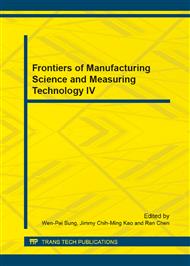p.381
p.385
p.391
p.396
p.401
p.405
p.409
p.413
p.417
Research on Attitude Singularity Problem of Small Tail-Sitter Aircraft
Abstract:
Singularity problem in attitude estimation of small tail-sitter aircraft with traditional algorithm is researched. According to the flight characteristics of small tail-sitter aircraft, a new algorithm is proposed. Vertical Euler angles whose singularity points are away from standard Euler angles are introduced. Only one set of angles are used in horizontal or near-vertical state to avoid singularity. Simulation results show that attitude angles can vary continuously and have high accuracy under the condition of a large tilting angle.
Info:
Periodical:
Pages:
401-404
Citation:
Online since:
August 2014
Authors:
Keywords:
Price:
Сopyright:
© 2014 Trans Tech Publications Ltd. All Rights Reserved
Share:
Citation:


